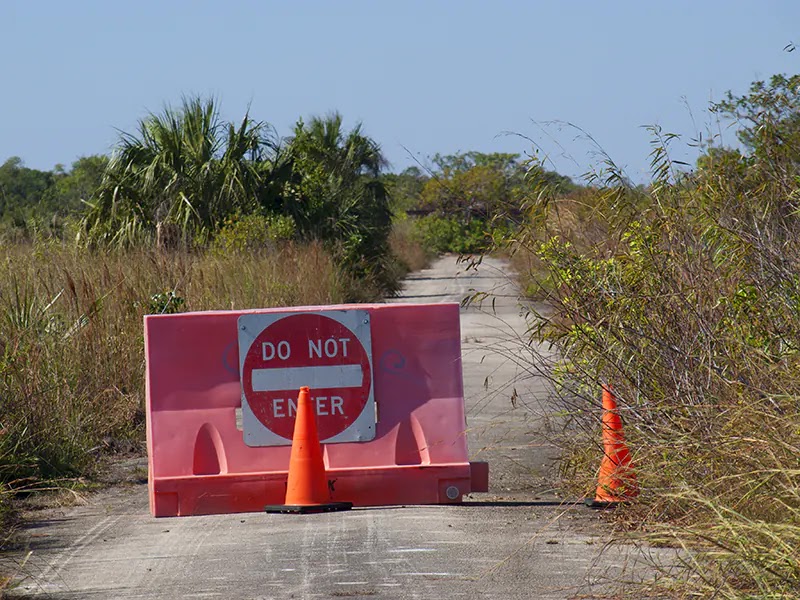Bear spray on wild boars or hogs: Does it work?
Hiking the Military Trail in the Kissimmee Prairie Preserve, we crossed path with a wild boar.

|
| Our wild boar crossing the Military Trail - License our images here. |
This happened a couple of hours before sunset. Previously, we had reached the Kissimmee River and went on our way back to the
campground. With seven more miles to go, we sat for a break and a snack
under the trees by the McGuire Hammock (right at this location).
The uninvited pig emerged from the forest thirty feet away from us. It was mid-November, the first month of the rut season in Florida and a time when males may behave aggressively. We stood up slowly. I had the bear spray in one hand and the .357 in the other, undecided on what to use if the boar charged.
Could bear spray stop a charging boar? I didn’t know, so was time to learn about wild boars.
Wild Boars Attacks: What’s The Risk
Wild boars have attacked humans since ancient times. One of the oldest
petroglyphs in the world reveals one case.

|
| Boar attack on human. Bhimbetka rock shelters, India (Photo by Bernard Gagnon). |
But don’t panic. The odds are in our favor because most wild pigs flee from
humans. Since 1825, only five peoples lost their lives in the United States because wild
boars attacks. This is a pretty safe record: five documented deaths in almost two
hundred years.
The data doesn’t compare to our chances of dying in a traffic
accident, but with the so called “Feral Swine” expanding through over 30 states in the
United States there is always risk. The last documented death from a wild boar attack happened in Texas in 2019.
Some wild hogs killed a lady after she got out of her car (check the link to
The New York Times at the end of this post for the complete story). And the danger is not only here in North America. In 2021 two wild boars
attacked the famous singer Shakira in a public park of the Spanish city of
Barcelona.
Today, the estimates of wild hogs in the United States range between six and nine
million. Half of them call Texas home. So, if you enjoy exploring the big outdoors, it’s important to learn how to
deal with these animals.
What Does Science Says About Wild Pig Attacks
A study from 2013 collected info on 412 wild pig attacks on humans and the findings show that:
• Most attacks happened in fall and winter - because of
breeding season and sows with piglets.
• The majority of the culprits were large solitary males.
• The majority of the culprits were large solitary males.
• Boar attacks happen in less than a minute.
• Most attacks were not fatal - but some left grave injuries.
• There were cases when an animal attacked twice.
To get an idea of what to expect, there are many videos of wild boar attacks
in YouTube. Most are charges against dogs and hunters (Warning: Some images
are bloody).
Learning More About Wild Hogs
All these names refer to pigs roaming wild:
1. Wild boar.
2. Wild hog.
3. Feral pig.
4. Feral hog.
5. Old World swine.
6. Razorback.
7. Eurasian wild boar.
8. Russian wild boar.
I will use the most popular names interchangeably to avoid boring you
(wild boar, wild hog, and wild pig). Keep in mind that the javelinas of the Southwest states are
not considered feral hogs. They are smaller mammals with many differences (read more
here).
Wild hogs are newcomers to North America. They arrived with the Spaniards
in the 1500s as food source and later, in the early 20th century, Russian
wild boars were introduced for hunting. Today all these wild pigs are seen as invasive species because their
rooting habits destroy crops and the landscape. We have seen their damages around many trails - even we have some pictures.
Wild pigs are more active at night but may wander during the day. These lazy fellas often rest for half of the day under the shade of
dense vegetation. Note that their level of activity drops in the chilly nights of winter.
Wild pigs don’t sweat and need water for cooling, so they live close to rivers, lakes, and ponds. The animals also coat their bodies with mud for
protection against insects and intense sun. Adult males are solitary, but females travel in groups. These groups are
called "sounders", and the biggest ones may reach up to 50 animals. An adult wild pig average weight falls between 150 to 200 pounds, but some
individuals go up into the 400 range. Their most common colors are black or dark brown.
Wild pigs have a bigger brain per unit of mass than their domestic
cousins - probably need to think more on how to survive in the wild. They also have better smell than farm grown pigs. Such intelligent beasts are always alert. They don’t like
surprises. Wild hogs are easily startled and this can provoke a defensive
attack.
Opportunistic omnivores, wild pigs can transform in aggressive predators. They
are also excellent scavengers and there are documented cases of feeding on
human corpses.
Capable of reaching 30 mph in a sprint, a wild boar will outrun us. You may escape them from a distance, but not much of a chance in a close encounter.
These pigs also carry diseases and some of them can spread to humans (read
about
the swine flu).
How to Minimize Chances of a Wild Hog Attack
• Don’t travel alone.
• Always be alert to wild hogs.
• Dogs may complicate things - leashed or unleashed. Many
suggest leaving them at home.
• Never threaten or chase a wild pig.
• Don’t get close to a wounded boar.
• Never corner the pig or block its path.
• If you encounter one, better take a detour or back away slowly.
• Refrain from doing aggressive movements.
What to Do if a Wild Boar Attacks
• Try to climb a tree to at least 6 feet from
the ground if possible.
• If no chance of escape, fight back with whatever you have
at hand.
• Always try to stay on your feet. There are
more chances of fatal injuries if you fall to the ground.
• In the event you end with your back on the floor, keep
your feet facing the pig and kick it on the head and snout.
• Wounds caused by wild pigs pose a high risk for infection. Seek
medical help as soon as possible.
What About Using Bear Spray On a Wild Boar?
Here we go for the crucial question of this post. Do we have an answer?
I couldn’t find good data that supports that bear spray is effective in
deterring a wild boar attack.
There is a study about a commercial odor repellent for feral pigs, but the product couldn’t prevent wild boars from entering sites prepared to lure them in
(I added a link to this research in the sources of this post).
If chemicals appear not to deter wild hogs, add their speed and the
tolerance to pain of their mucous membrane, and I won’t trust much the
chances of my bear spray stopping a wild boar. The fast animal may
overpass the spray discharge.
A firearm with the right caliber will be more effective if one can shoot
well under such stress - easier said than done.
Great that we didn’t have to test how effective is our bear spray on a
charging boar. Our wild friend stood for a short while in the middle of the trail - it
felt an eternity. Then, took another bored glimpse at us and, slowly and confident,
vanished into the bushes.
We breathed very relieved of meeting a nice wild pig and, a couple of minutes later, resumed our seven-mile hike back to the Kissimmee Prairie
campground. We arrived after the sunset and were welcomed by a beautiful moon. The moon of
the wild boar. LOL!

|
| Rising moon on the Kissimmee Prairie. |
(Go to this post for bear information - including related to bear spray. At the end there are links to more posts about bears.)
Sources of info for this post:
Wild Pig Attacks on Humans, Proceedings of the 15th Wildlife Damage Management Conference,
2013.
Feral Hogs Attack and Kill a Woman in Texas, The New York Times, 2019.
Shakira: Singer attacked by a pair of wild boars, BBC News, 2021.
Adaptation of wild boar (Sus scrofa) activity in a human-dominated
landscape, BMC Ecology, 2020.
Evaluation of an odor repellent for protecting crops from wild boar
damage, Journal of Pest Science, 2012.
A Dysfunctional Sense of Smell: The Irreversibility of Olfactory
Evolution in Free-Living Pigs, Evolutionary Biology, 2014.
Feral Hogs in North America: An Overview, Noble Research Institute, YouTube channel.




Comments
Post a Comment